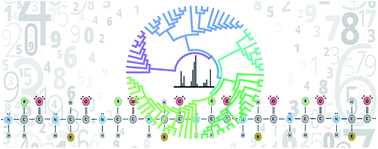Protein phylogenetics with mass spectrometry. A comparison of methods†
Abstract
Advances in protein mass spectrometry have provided the ability to identify and sequence proteins with unprecedented speed, sensitivity and accuracy. These benefits now offer advantages for studies of protein evolution and phylogeny avoiding the need to generate and align DNA sequences which can prove time consuming, costly and difficult in the case of large genomes and for highly diverse organisms. The methods of phylogenetic analysis using protein mass spectrometry can be classified into three categories: (1) de novo protein sequencing followed by multiple sequence alignment for classical phylogenetic reconstruction, (2) direct phylogenetic reconstruction using expressed protein mass profiles exploited in microbial biotyping applications, and (3) the construction of trees using proteolytic peptide mass map or fingerprint data. This review describes the three approaches together with the relevant tools and algorithms required to implement them. It also compares each of these alternative protein based methods alongside conventional gene sequence based phylogenetics.

- This article is part of the themed collection: Analytical Methods Review Articles 2021

 Please wait while we load your content...
Please wait while we load your content...